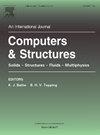Polygonal elements with Richardson-extrapolation based numerical integration schemes for hyperelastic large deformation analysis
IF 4.4
2区 工程技术
Q1 COMPUTER SCIENCE, INTERDISCIPLINARY APPLICATIONS
引用次数: 0
Abstract
This paper presents a novel approach based on polygonal finite elements (PFEM) for hyperelastic large deformation analysis. Compared to the mesh of quadratic 8-node quadrangular finite elements (FEM-Q8), which is usually used in this problem type, a mesh of polygonal element usually requires less number of nodes (and thus less number of degrees of freedom), given the same number of elements. Traditionally, numerical integration in PFEM involves two steps: i) sub-division of polygonal (element) domain into triangular cells, then ii) Dunavant's integration scheme is conducted in the triangular cells. Each求助全文
约1分钟内获得全文
求助全文
来源期刊

Computers & Structures
工程技术-工程:土木
CiteScore
8.80
自引率
6.40%
发文量
122
审稿时长
33 days
期刊介绍:
Computers & Structures publishes advances in the development and use of computational methods for the solution of problems in engineering and the sciences. The range of appropriate contributions is wide, and includes papers on establishing appropriate mathematical models and their numerical solution in all areas of mechanics. The journal also includes articles that present a substantial review of a field in the topics of the journal.
 求助内容:
求助内容: 应助结果提醒方式:
应助结果提醒方式:


